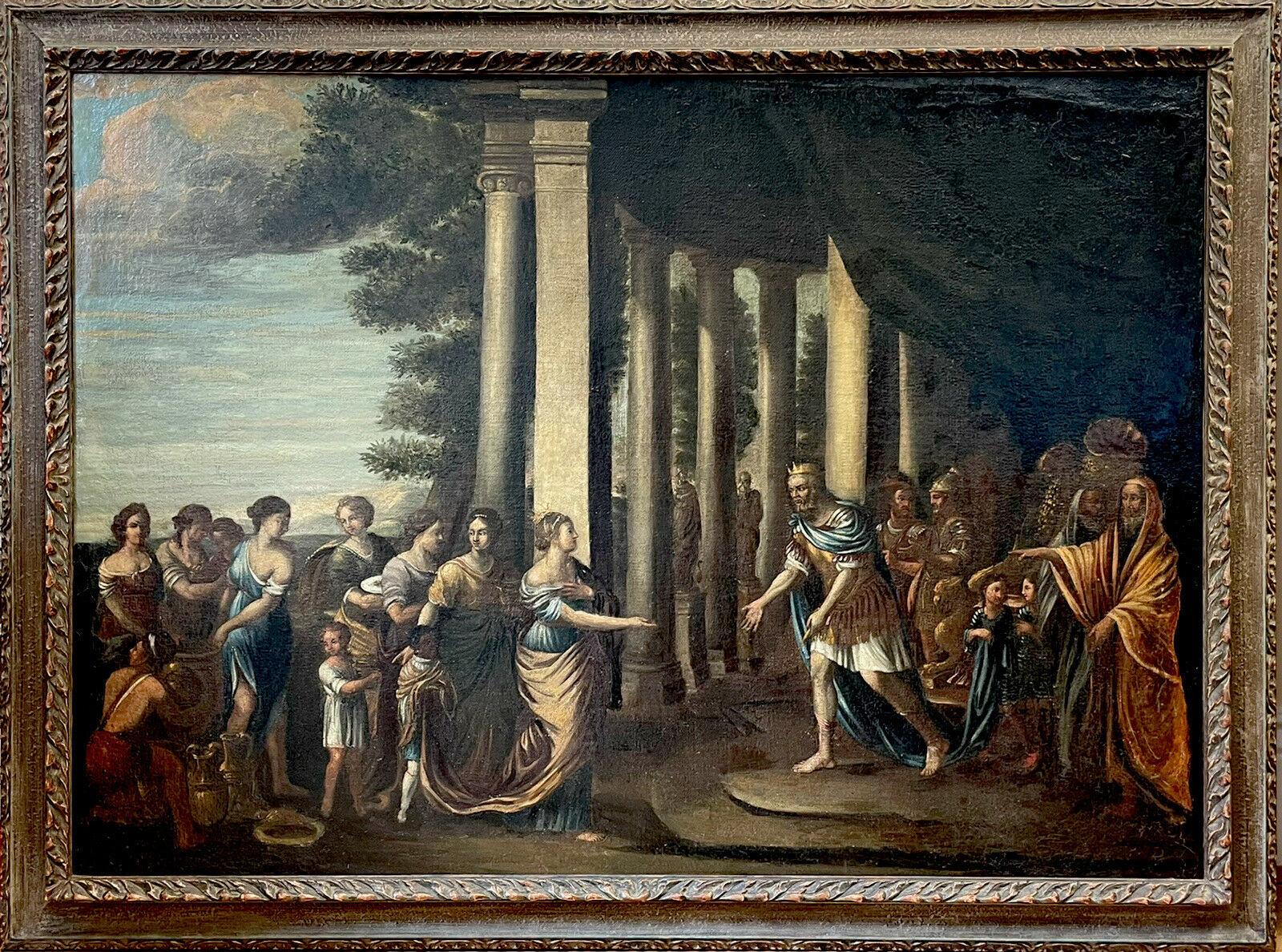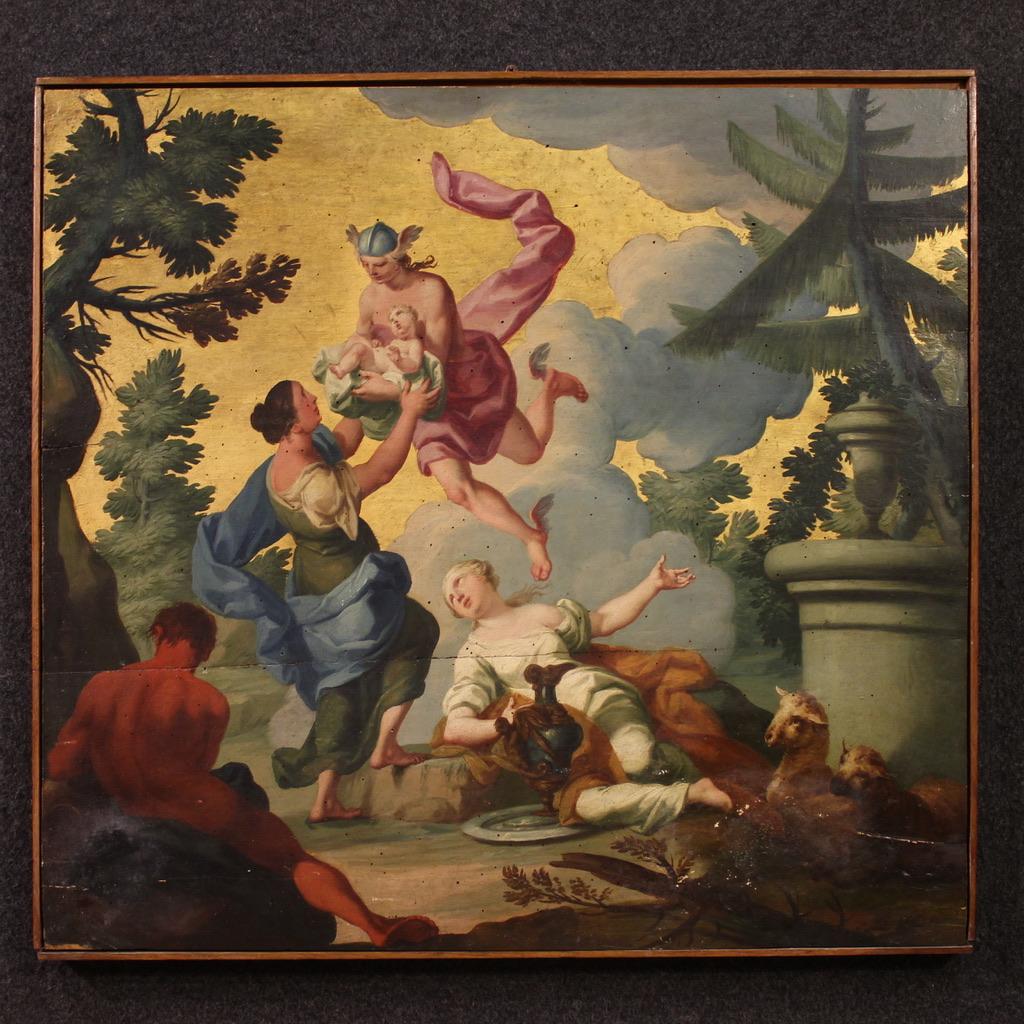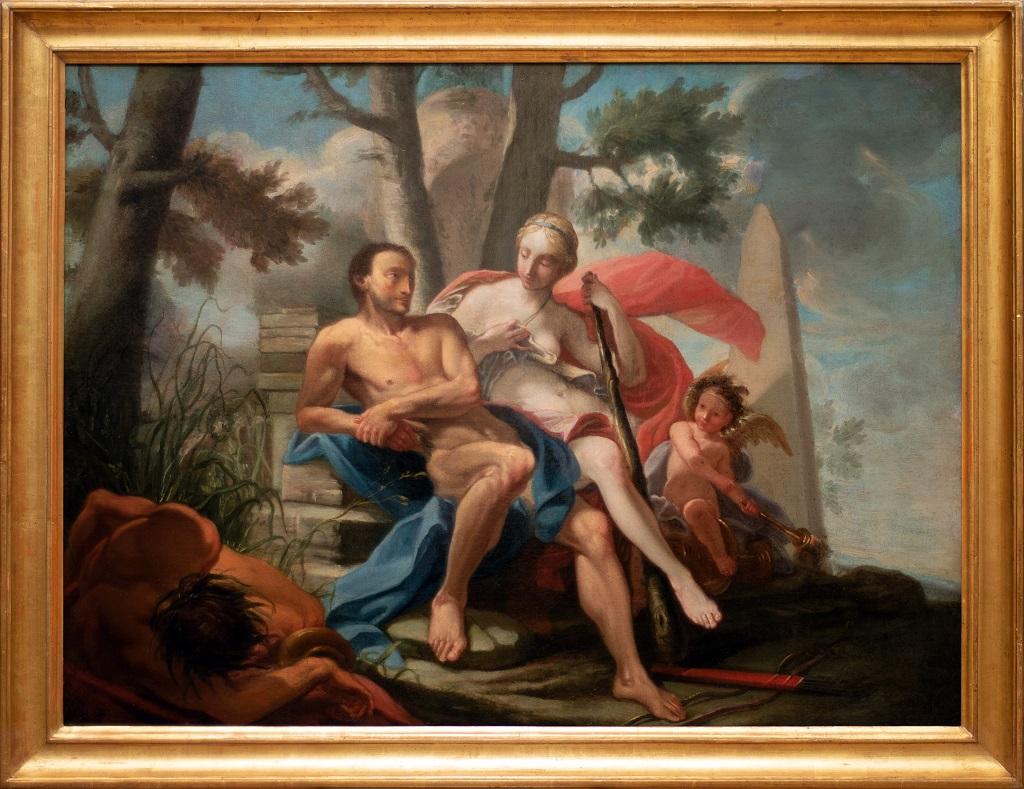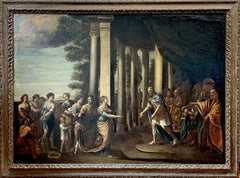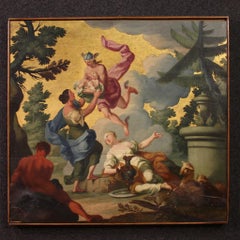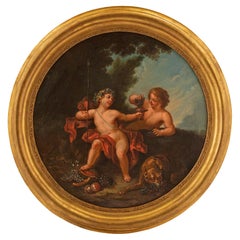Items Similar to Alexander The Great Persians Fontebasso 18th Century Paint Oil on canvas
Video Loading
Want more images or videos?
Request additional images or videos from the seller
1 of 23
Alexander The Great Persians Fontebasso 18th Century Paint Oil on canvas1730-1760
1730-1760
$18,046.28
$22,557.8520% Off
£13,405.37
£16,756.7120% Off
€15,080
€18,85020% Off
CA$24,896.10
CA$31,120.1320% Off
A$27,367.67
A$34,209.5820% Off
CHF 14,383.19
CHF 17,978.9920% Off
MX$332,343.15
MX$415,428.9320% Off
NOK 179,426.68
NOK 224,283.3520% Off
SEK 169,994.16
SEK 212,492.7020% Off
DKK 114,796.77
DKK 143,495.9720% Off
About the Item
Francesco Fontebasso
(Venice 1709 - Venice 1769)
Alexander the Great grants clemency to the Persians
Oil on canvas
108 x 153 cm.
In frame 120 x 164 cm.
Fascinating for its interesting subject matter, the beautiful painting draws its inspiration from the conquest stories of the great Alexander the Great, portrayed giving clemency to a general of the defeated Persian army.
Entering into the details of the refined composition, Alexander is portrayed standing with a triumphant air and aware of his own glory, while granting clemency to the people of Persia, here symbolically depicted by two opposing militiamen, one kneeling in submission and a second standing held captive. The details of their armour are interesting, where lion heads, a Persian symbol since time immemorial, stand out, as well as the typical long sabres.
Historically, we know that the Battle of Issus (333 BC) definitively gave Alexander dominance of the greatest empire ever created, forcing Darius III to flee and causing panic among the Persian troops, who decided to take Alexander's side, demanding clemency.
Alexander treated them with respect and, after swearing allegiance to them, incorporated them into his army, but always imposing his own dominance: our author has immortalised this moment.
This is a valuable work, executed by an 18th century Venetian painter and attributable precisely to Francesco Fontebasso (Venice, 1709 - 1769), a painter who tackled this theme on several occasions, a leading protagonist of the extraordinary painting season of 18th century Venice.
His training took place in Sebastiano Ricci's workshop, followed by stays in Bologna and Rome. Upon his return to Venice, he allowed himself to be won over by the impetuous chiaroscuro effects of the young Giambattista Tiepolo, whose influence would be evident in all of his work.
In its realisation, Fontebasso gives us a work that is strongly emotionally engaging, both for the magnificence of the painting and the theme proposed. In fact, the subject reveals the magnanimity and clemency of the sovereign who often welcomed his conquered enemies with extreme consideration.
The true poetry of the painting is the painter's mastery of descriptive detail, so much so as to arouse in the spectator a sense of profound admiration, enraptured by the virtuosity of the technique, the profusion of detail, with the exceptional richness of the details of the uniforms rendered with great skill.
Good state of preservation. Rintelato. Pictorial matter in very good condition, with some old restorations scattered over the surface.
ADDITIONAL INFORMATION:
The painting is sold complete with an attractive gilded frame and is accompanied by a certificate of authenticity and descriptive iconographic card.
We take care of and organise the transport of the purchased works, both for Italy and abroad, through professional and insured carriers.
Contact us for any information, we will be happy to answer you.
- Attributed to:Francesco Fontebasso (Venice 1709 -1769)
- Creation Year:1730-1760
- Dimensions:Height: 47.25 in (120 cm)Width: 64.57 in (164 cm)
- Medium:
- Movement & Style:
- Period:
- Condition:
- Gallery Location:Riva del Garda, IT
- Reference Number:1stDibs: LU988115699352
About the Seller
4.9
Platinum Seller
Premium sellers with a 4.7+ rating and 24-hour response times
Established in 2017
1stDibs seller since 2018
260 sales on 1stDibs
Typical response time: <1 hour
- ShippingRetrieving quote...Shipping from: Riva del Garda, Italy
- Return Policy
Authenticity Guarantee
In the unlikely event there’s an issue with an item’s authenticity, contact us within 1 year for a full refund. DetailsMoney-Back Guarantee
If your item is not as described, is damaged in transit, or does not arrive, contact us within 7 days for a full refund. Details24-Hour Cancellation
You have a 24-hour grace period in which to reconsider your purchase, with no questions asked.Vetted Professional Sellers
Our world-class sellers must adhere to strict standards for service and quality, maintaining the integrity of our listings.Price-Match Guarantee
If you find that a seller listed the same item for a lower price elsewhere, we’ll match it.Trusted Global Delivery
Our best-in-class carrier network provides specialized shipping options worldwide, including custom delivery.More From This Seller
View AllDiana Boullogne Mythological Paint Oil on canvas old master 17/18th Century
Located in Riva del Garda, IT
Bon Boullogne (Paris, 1649 - Paris, 1717) workshop of
Episodes from the myth of Diana
oil painting on canvas
Dimensions: 84 x 114 cm.
with antique frame 100 x 132 cm.
The beautiful painting proposed shows a series of episodes taken from the myth of the divinity Diana, the Roman divinity of hunting, forests and wild animals, masterfully captured in this valuable painting, which shows a luxuriant wood, a favorite place of the divinity, as a theater of his adventures.
The composition opens, on the left, with a sort of presentation of the divinity, portrayed as an attractive young girl, surrounded by her faithful Nymphs, one of whom holds her quiver with arrows, and by one of her beloved dogs. hunting her.
The 'story' continues in the central part where we can see the divinity during a wild boar hunt...
Category
Late 17th Century Old Masters Paintings
Materials
Oil
$8,474 Sale Price
20% Off
Ghisolfi Paint Oil on canvas Old master 17th Century Architectural Capriccio Art
By Giovanni Ghisolfi (Milan 1623 - 1683)
Located in Riva del Garda, IT
Giovanni Ghisolfi
(Milan 1623 - 1683)
Architectural capriccio with ruins of an Ionic temple
Oil painting on canvas
73 x 87 cm.,
within a gilded wooden frame 87 x 100 cm.
This quali...
Category
17th Century Old Masters Paintings
Materials
Oil
$8,587 Sale Price
35% Off
Knight Van Douw Paint Oil on canvas Old master 17/18th Century Flemish Art Italy
By Simon Johannes van Douw (Antwerp c. 1630 - c. 1677)
Located in Riva del Garda, IT
After Simon Johannes van Douw (Antwerp c. 1630 - c. 1677)
The stop of a traveler on horseback near a post station
Oil painting on canvas
45 x 55 cm
In frame cm. 55 x 65
In this pleasant painting, depicting a knight parked near a post station, the Flemish tradition is based on a strong Italianizing sensitivity, especially by observing the setting and its peculiar brightness.
The mixture of genres and the particular style of execution make it easy to trace the authorship back to a Nordic author but active in Rome, or strongly influenced by the style in vogue in the Eternal city, between the seventeenth and eighteenth centuries: we are referring, in in particular, to a follower of the Antwerp Simon Johannes van Douw.
The chromatic elegance and refinement with which he outlines the figures are typical aspects of his painting.
The scene takes place outside a cottage, probably a post office for travelers, where a modest family divides the tasks by assisting the knights. We see a young boy who hands water to the horse before he sets off again, the father is preparing to feed him with straw and the mother who instead takes care of the little son.
The Italian reminiscences, evident in our painting, have been absorbed by many Northern European authors such as Nicolaes Berchem, Philips Wouwerman or Johannes Lingelbach, all inspired by the leader Pieter van Laer...
Category
18th Century Old Masters Paintings
Materials
Oil
$4,231 Sale Price
20% Off
Aeneas Dido Pseudo-caroselli Roman school 17th Century Paint Oil on canvas
Located in Riva del Garda, IT
Aeneas and Dido
Attributed to Pseudo-Caroselli (Rome, active c. 1630/1650)
Oil on canvas 148 × 93 cm. framed 162 × 107 cm.
The episode depicted in the superb canvas illustra...
Category
17th Century Old Masters Paintings
Materials
Oil
$18,070 Sale Price
20% Off
Landscape Reder 17/18th Century Pait OIl on canvas Old master
Located in Riva del Garda, IT
Christian Reder (Leipzig 1656 - Rome 1729)
Landscape with boar hunting
Oil on canvas 66 x 132 cm In frame 76 x 143 cm
We present this delightful work, of which the matching ...
Category
17th Century Old Masters Paintings
Materials
Oil
$6,098 Sale Price
20% Off
Portrait King Solomon Desubleo Paint Oil on canvas Old master 17th Century Art
Located in Riva del Garda, IT
Michele Desubleo (Maubeuge, 1602 - Parma, 1676) - attributable
Portrait of gentleman like Solomon, the wise king
Oil painting on canvas
120 x 141 cm., By gilded wooden frame cm. 134 x 162 cm.
The beautiful painting shows us an image of the famous Solomon king, legendary biblical figure who became the personification of the good reigning over the centuries, and proverbially recognized as one of the wisest politicians in history. The features of the off are presumably those of the client of the work, who wanted to emphasize his image by impersonating a character with legendary fame.
The reigning, with an elegant coron head of Corona of Eastern Foggia, is dressed in a sumptuous silk clothes...
Category
17th Century Old Masters Paintings
Materials
Oil
$18,046 Sale Price
20% Off
You May Also Like
HUGE 17thC ITALIAN OLD MASTER OIL PAINTING - KING & COURT FIGURES ROMAN BUILDING
Located in Cirencester, Gloucestershire
Artist/ School: Italian School, 17th century.
Title: A King and Queen before court figures, amidst a classical landscape with Roman columns.
Medium: oil painting on canvas, framed
...
Category
17th Century Old Masters Figurative Paintings
Materials
Canvas, Oil
18th Century Oil on Panel Italian Mythological Painting, 1760
Located in Vicoforte, IT
A rare 18th-century Italian painting. Oil on panel artwork depicting a captivating mythological subject, Mercury delivers the infant Bacchus to the Nymphs of Mount Nysa. According to...
Category
1760s Figurative Paintings
Materials
Oil, Wood
Hercules and Omphale - Oil Painting on Canvas - 18th Century
Located in Roma, IT
Hercules and Omphale is an original painting realized in France between the end of the 18th and the beginning of the 19th Century.
Original oil painting on canvas. Dimensions: 73 x...
Category
Late 18th Century Modern Figurative Paintings
Materials
Canvas, Oil
Italian 18th Century Neo-Classical Oil on Canvas Painting
Located in West Palm Beach, FL
An extremely charming Italian 18th century Neo-Classical oil on canvas painting. The circular painting retains its original giltwood frame with a beautiful mottled designs and finely...
Category
Antique 18th Century Italian Neoclassical Paintings
Materials
Canvas, Giltwood
Mythological Scene - Oil on Board - 18th Century
Located in Roma, IT
Mythological Scene is a mixed colored painting on board realized by Anonymous artist in the XVIII century.
The artwork represents a mythological scene with women and cherubs.
Inclu...
Category
18th Century Figurative Paintings
Materials
Board, Oil
18th Century Biblical Scene Italian School Saint Joseph Oil on Canvas Brown Gold
Located in Sanremo, IT
Painting oil on canvas depicting a soldier handing the crown to Saint Joseph, measuring 76 x 61 cm without frame and 95 x 80 cm with frame by an Italian School of the second half of ...
Category
1760s Italian School Figurative Paintings
Materials
Canvas, Oil
More Ways To Browse
Venice Oil
Old Masters Paintings Of Venice
Venice Framed Art
Oil Painting Of A Lion
Antique Venice Painting
Alexander The Great
Antique Sovereigns
Venetian Painters
Antique Persian Painting
Persian Oil Painting
Old Masters Venice
Persian Art Antique Framed
Alexander Grant
Antique French Portrait Paintings
19th Century French School
Contemporary Impressionism
Contemporary Korean Art
Winter Scene
